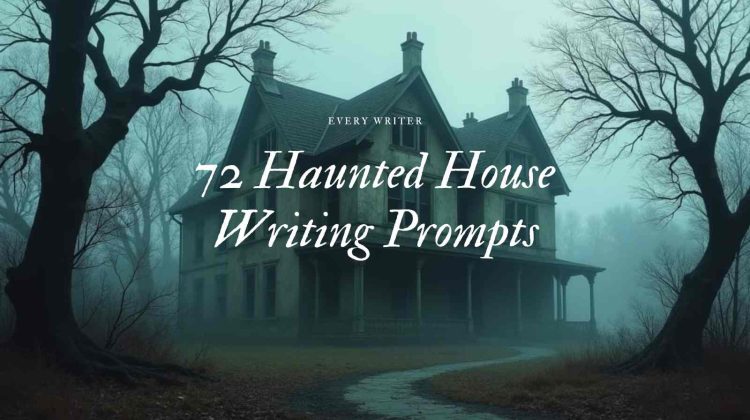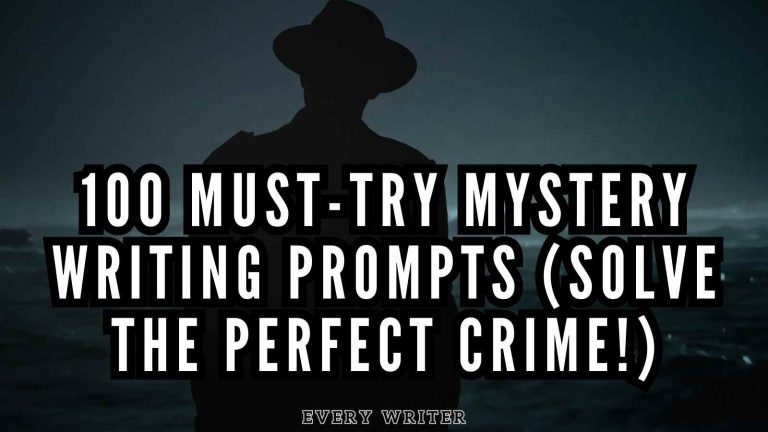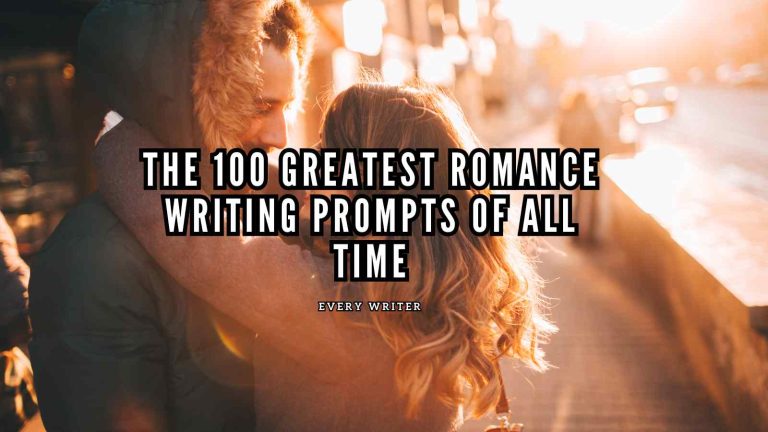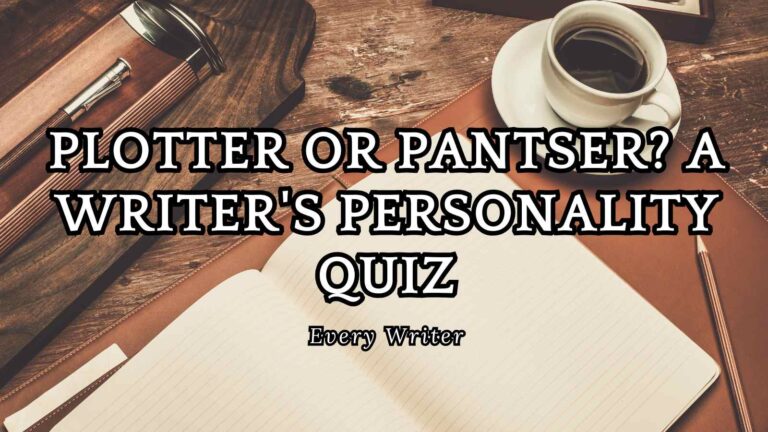72 Haunted House Writing Prompts
Are you searching for spine-tingling inspiration for your next horror story? Look no further than this comprehensive collection of 72 Haunted House Writing Prompts that delve into the darkest corners of haunted locations. From abandoned asylums to cursed lighthouses, these prompts offer a diverse range of supernatural scenarios to spark your creativity.
Our carefully curated list of 72 Haunted House Writing Prompts explores the intersection of time, space, and the supernatural. Each prompt features a unique twist on classical haunted location tropes, incorporating elements of time travel, parallel dimensions, and prophetic warnings. Whether you’re writing about a Victorian mansion where mirrors serve as windows to tragic parallel realities or an abandoned department store where fitting rooms reveal fatal futures, these 72 Haunted House Writing Prompts provide rich foundations for your horror fiction.
What sets these 72 Haunted House Writing Prompts apart is their focus on innovative supernatural mechanisms. Rather than relying on traditional ghost stories, each prompt introduces a unique paranormal element – from haunted carousel horses that gallop off with missing children to industrial machines that manufacture items from deadly historical accidents. These prompts transform ordinary locations into extraordinary portals of horror.
The 72 Haunted House Writing Prompts collection spans various architectural settings, from grand opera houses to humble covered bridges, each harboring its own dark secrets. Many prompts incorporate modern elements like security cameras, smartphones, and social media, creating a perfect blend of contemporary fears and timeless supernatural dread. Whether you’re crafting a short story or developing a full-length novel, these prompts offer versatile launching points for your haunted tales.
For writers seeking to explore psychological horror alongside supernatural elements, these 72 Haunted House Writing Prompts include scenarios that blur the lines between past and present, reality and nightmare. With settings ranging from abandoned asylums where rooms reflect their patients’ mental states to historic theaters where plays predict audience members’ fates, each prompt opens doors to both supernatural and psychological exploration of fear.
Here are the 72 haunted house writing prompts:
- A family inherits an old library where books rearrange themselves at night. They discover that the books are forming sentences, telling the story of a tragedy about to repeat itself – and the last chapter is still being written with their daily activities.
- A real estate agent specializing in “haunted property restoration” discovers that every house she’s successfully “cleansed” is connected by an underground tunnel system. The original blueprints suggest these tunnels lead to one final house that’s been sealed off for centuries.
- In a historic hotel, the service elevator only stops at floors that no longer exist. Room service workers who accidentally board it find themselves delivering meals to guests who checked in decades ago – and some of them don’t want to let the workers leave.
- A restoration expert working on an abandoned amusement park notices that the carousel animals change positions overnight. Security footage shows the horses galloping off every midnight, returning with new riders who match the descriptions of local missing children.
- A nursing student takes a job at an old hospital scheduled for demolition, helping to relocate patients. They start finding rooms that aren’t on the blueprints, filled with patients whose admission dates precede the hospital’s construction. Each “patient” wants to share their story – but only after sunset.
- During renovations of a Victorian mansion, workers discover that all the mirrors are actually windows into other versions of the house, each showing a different tragic event. The reflections begin stepping through, each claiming their version of the house is the real one.
- A lighthouse keeper notices that the light sometimes shines inward instead of out to sea. On foggy nights, the beam reveals ghostly figures climbing the stairs – but they’re ascending far beyond the lighthouse’s actual height, into an impossibly tall version of the tower.
- The new owner of a historic theater realizes that every play performed there manifests elements from the audience’s lives into its plot. As the productions become increasingly personal and predictive, they discover that the final act always comes true – and this season’s closing show is a tragedy.
- In a recently renovated apartment building, residents notice their pets staring at the same corner in every room. Those who photograph these spots find that each image shows a different room from the building’s past – and the timeline of these rooms is moving steadily toward a horrific event.
- A small town converts its old courthouse into a museum, but visitors keep finding themselves in “living exhibits” of historical trials. They can’t leave until they serve as jury members, but they soon realize that their verdicts are changing the present – and some of the defendants are their own ancestors.
- A cemetery groundskeeper maps out decades of unusual visitor behavior and discovers that mourners unconsciously walk in patterns that form ancient symbols. The symbols appear to be a countdown, and they’re nearly complete.
- An urban explorer documents abandoned places but starts noticing that rooms in completely different buildings are exact copies of each other – down to the placement of dust particles. Following this pattern leads to a door that theoretically exists in every abandoned building simultaneously.
- During deep cleaning of an old cinema, workers discover a hidden screening room with one seat that’s still warm. The projector runs without power, showing films of the viewers’ worst memories – but in each replay, a dark figure moves closer to the person in the memory.
- A cave tour guide notices that the number of stairs leading down changes each day, while the number going up stays constant. Groups that take the longer route down report hearing their own voices echoing back, begging them to turn around.
- An antique store owner realizes that every item’s reflection in the shop windows shows its darkest moment – a wedding dress covered in blood, a rocking chair mid-fall, a doll surrounded by flames. The reflections are starting to match current dates rather than past ones.
- In a recently restored Victorian house, all the shadows fall in the wrong direction. The new owners discover that the shadows are actually from a parallel version of the house where a horrific crime is about to occur – and the shadows are trying to warn them.
- A maintenance worker at an old apartment complex discovers that every unit’s bathroom mirror shows the same reflection: an empty communal washroom from when the building was a 1920s hotel. The reflection has started showing current residents walking into that bathroom – but they never walk out.
- After a flood, a small-town church’s basement reveals a second bell tower extending deep underground, complete with a bell that rings upward. Those who hear it find themselves compelled to dig deeper, claiming they’re being called to “the first congregation.”
- The new curator of a maritime museum notices that water damage on the walls forms different patterns depending on who’s looking at them. Visitors who can see the same pattern share a connection – they’re all descendants of passengers from a ship that vanished a century ago.
- A prison-turned-historical site offers overnight ghost tours, but guests keep waking up in cells that don’t exist on the modern blueprints. Their phones show they’ve only been asleep for minutes, but their bodies age hours for each minute spent in these phantom cells.
- During renovation of an old post office, workers find hundreds of undelivered letters dating back decades, all addressed to the same non-existent house number. Each letter is a warning about something that later came true. New letters keep appearing, written in increasingly familiar handwriting.
- A real estate photographer notices that every kitchen they shoot contains a reflection of the same dinner party in its windows – but the guests are different in each house. They realize they’re photographing the last meal of every family who lived in these homes, and their own kitchen window has started showing a similar scene.
- The janitor of an old school discovers that items left in lost and found reappear in old yearbook photos. The more times an item is reclaimed, the closer the yearbook students move to the edges of their photos, making room for something that’s slowly emerging in the center.
- A surveyor mapping abandoned subway stations finds that the echo delay in each tunnel correlates to specific dates in the city’s history. When they match the echoes to historical events, they realize the tunnels are counting down to something – and today’s date is getting closer.
- A bed & breakfast owner discovers that guests who stay in Room 214 wake up in different decades of the hotel’s history. They can return to the present by falling asleep again – but each time, they bring back something small that shouldn’t exist anymore. The items are starting to form a pattern that points to a future event.
- During repairs on an old covered bridge, workers find that measurements taken at sunset are drastically different from those taken at dawn. Local records suggest the bridge used to connect to another town that disappeared a century ago – and at twilight, lights are becoming visible on the other side.
- A university archivist notices that books in the rare manuscripts section are developing identical water damage on specific pages. When the damaged text is compiled, it forms instructions for a ritual – written in the handwriting of future students who haven’t enrolled yet.
- The new owner of a converted funeral home finds that every room’s temperature drops by exactly one degree each night. Security cameras show brief glimpses of past services playing out in reverse, with the deceased walking backward out the door. The temperatures are approaching freezing, and the playback is reaching the home’s first funeral.
- In an abandoned mall, all the store mannequins face the same direction when photographed, regardless of their actual positions. Following their gaze leads to a service corridor that doesn’t appear on any blueprint – and someone’s been marking off daily attendance on its walls.
- A lighthouse keeper’s logbook shows the same mysterious entry every seven years: “The tide brought them back.” Current weather data reveals that next week’s conditions will perfectly match those recorded during each previous entry – and small objects from the keeper’s childhood are washing up on shore.
- During renovation of an old opera house, workers discover that the building’s acoustics make whispers audible only to people sharing the same fate. Those who can hear the whispers realize they’re listening to their own final performances – but one person hears only silence.
- A park ranger finds that certain trees in the forest contain perfect cross-sections of human dwellings when cut – complete with furniture and frozen figures. The scenes are becoming more modern with each tree, and the newest saplings are starting to show familiar rooms.
- The caretaker of an abandoned asylum discovers that each room’s decay exactly mirrors the mental state of its last occupant. In one wing, the rooms are getting cleaner and more organized by themselves, suggesting that something is working its way toward consciousness.
- A historic diner’s jukebox plays songs that don’t exist – except in the memories of certain customers. Those who recognize the music share more than just memories: they’re all about to experience events eerily similar to the lyrics, and the songs are getting darker.
- Residents of a high-rise notice that the elevator security cameras show different floor layouts depending on which button is pressed. The “basement” footage reveals a sub-basement that shouldn’t exist, where every resident’s most treasured lost possession is neatly arranged – including items they haven’t lost yet.
- A museum guard realizes that artifacts from different historical periods are communicating through their reflections in the display cases. The objects are arranging themselves to recreate a specific moment in time – but the date they’re depicting hasn’t happened yet, and it matches multiple doomsday predictions.
- A photographer documenting old barns discovers that each photo contains a family portrait in the wood grain patterns. The families are posed similarly, but in each image, one more person is turned away from the camera. In their most recent photo, everyone is facing backward except one child who’s staring directly at the viewer.
- The owner of a renovated train station finds that every night at 3:17 AM, the old arrival board clicks to life, displaying destinations that don’t exist. Passengers begin showing up to catch these impossible trains, each carrying a ticket dated 50 years in the future, all bound for the same final stop.
- In a restored Victorian dollhouse museum, the miniature furniture rearranges itself to match the real-time layouts of visitors’ homes. Those whose houses match a display perfectly receive a tiny handwritten eviction notice – and begin finding doll-sized furniture replacing their own.
- A night watchman at an old factory discovers that the machines turn themselves on in sequence, manufacturing products from different eras. Each item produced is something that caused a death in its time – and the products are becoming increasingly modern.
- The new owners of a converted monastery find that the stained glass windows show different scenes depending on the viewer’s sins. People who see the same imagery share dark secrets, but one window remains black until sunset – when it begins showing future transgressions.
- During renovation of an old ice rink, workers discover that the ice never melts in one specific circle. Those who skate through this spot experience memories of past skaters – but the most recent memories are of events that haven’t happened yet, showing increasingly disturbing accidents.
- A librarian notices that books in the genealogy section are updating themselves, showing alternative family trees where different choices were made. Readers who find their own trees discover branches that end abruptly – always on the same future date.
- The caretaker of an abandoned water park finds that certain slides still flow with water despite being disconnected from any source. Each slide’s water tastes like a different memory to those who drink it, but everyone tastes copper in the newest attraction – which wasn’t there yesterday.
- In a historic restaurant, the mirrors show diners eating their last meals – not their last meal at the restaurant, but their actual final meal in life. New customers avoid looking at their reflections, until one person sees themselves eating their current dinner.
- A real estate agent specializing in historical properties realizes that every house they’ve sold contains a room that only appears in photographs taken at the exact time of death of previous owners. The agent’s own home has started developing an unfamiliar doorway in their recent selfies.
- The superintendent of an old apartment building discovers that the laundry room machines work backwards on full moons – removing stains from history rather than clothes. Residents who use these machines find past mistakes being undone, but each correction causes a worse event in the present.
- A lighthouse keeper notices that the fog horn sounds different to each listener, playing snippets of conversations from their future. Those who hear complete sentences begin disappearing, only to be found walking the beach years later, perfectly preserved and speaking in fog horn frequencies.
- A hotel maintenance worker discovers that room thermostats don’t control temperature – they control time. Each degree up moves the room one year into the future, each degree down goes back. A guest has been slowly turning their thermostat lower for weeks, trying to return to prevent something, but the past is starting to fight back.
- In an old department store’s fitting rooms, mirrors show customers wearing clothes they owned at significant moments in their lives. A teenager sees herself in a prom dress she hasn’t bought yet, covered in something that looks like red punch – until someone realizes it’s not punch at all.
- The new owners of a converted lighthouse discover that the light beam doesn’t warn ships away – it collects stories from drowning victims. Each flash captures a last memory, but lately, the memories are from people who are still alive, showing future disasters that all share the same date.
- A storage facility manager notices that empty units fill themselves with furniture and belongings from pivotal moments in future renters’ lives. The items vanish when those moments pass, but Unit 248 has been accumulating objects for years – all belonging to the manager, all associated with increasingly disturbing events.
- During renovations of an old courthouse, workers find that the judge’s chamber shows different versions of each case based on different verdicts. Visitors see outcomes from their own future trials – but everyone sees the same final case, where all past visitors are jointly accused of something terrible.
- The curator of a music hall discovers that the building’s acoustics perfectly preserve every sound ever made inside it. By adjusting the antiquated ventilation system, they can tune into different years – but someone has been deliberately tuning into next year, and the future sounds are getting closer to silence.
- A bowling alley mechanic finds that the pins in lane thirteen rearrange themselves to spell messages when they fall. Regular players start seeing predictions of their fate in the fallen pins, but one bowler’s pins never fall – they vanish instead, and the darkness behind them seems endless.
- In a restored Victorian bathhouse, each pool reflects a different era of the building’s history. Swimming in them lets you experience that time period, but guests are returning with increasingly valuable historical artifacts – and the city’s modern buildings are being replaced with their historical versions.
- The night guard at a wax museum notices that the figures trade faces at midnight. Each morning, the faces show more suffering than before, and visitors are starting to recognize their own features in the displays – aged by decades and frozen in expressions of horror.
- A cartographer mapping an old asylum discovers that the building’s dimensions change based on the mental state of whoever measures them. Those experiencing déjà vu find extra rooms containing scenes from their past, but one surveyor mapping during a nightmare found a wing full of rooms from everyone’s future terrors.
- The owner of a converted radio station finds that certain frequencies broadcast listeners’ thoughts. Late-night tuning reveals increasingly dark secrets, until someone discovers a frequency that only plays thoughts people will have tomorrow – and everyone’s thinking about running.
- In an old photo studio, developed pictures show subjects aging in real-time after being printed. Customers start requesting photos of their future selves, but everyone photographed after sunset appears in the same location, gathered around something just out of frame.
- Residents of an apartment building discover their mail is being delivered decades out of order. When they start receiving letters from their future selves, they realize every warning contains the same postscript: “Whatever you do, don’t use the basement washing machines after midnight.” But the warnings arrive too late – they’ve already been doing laundry at night for weeks.
- A restoration expert working on a carousel finds that each mirror on the ride reflects a different decade. Children who catch their reflection see themselves at different ages – until one child appears exactly the same in every mirror, waving to someone behind the viewer.
- The new owner of a converted clock tower realizes that each clock face shows a different time. Visitors see the time of their most life-changing decision – but lately, everyone’s seeing the exact same future moment, and their watches are slowly synchronizing to match it.
- During renovation of an old candy factory, workers discover a hidden tasting room where the samples reveal memories instead of flavors. The newest batch of candies shows memories that haven’t happened yet, all featuring the same dark figure standing closer in each preview.
- A historical reenactor at a colonial village notices that the buildings are gradually becoming more “authentic” – replacing modern repairs with original materials. As the site returns to its true historical state, visitors begin disappearing, only to appear in period photographs looking increasingly distressed.
- The curator of a maritime museum finds that artifacts from shipwrecks rearrange themselves at night to recreate their vessel’s final moments. A collection from a recently discovered wreck keeps forming the layout of the museum’s own floor plan, with tiny figures representing the current staff.
- In a newly restored movie palace, the ornate ceiling mural changes scenes based on the collective anxieties of the audience below. During a late-night screening, patrons notice the painted figures are watching a film that looks exactly like their current situation – but it’s a few minutes ahead.
- A park ranger discovers that certain trees in the ancient forest contain complete years of memories when cut – like rings, but playing videos of events that happened in their shade. The newest saplings are somehow showing future memories, and every single one shows the forest on fire.
- The owner of a bed & breakfast learns that each room’s decor subtly changes to match its occupant’s biggest regret. A guest who’s never made a major mistake gets a completely empty room – until objects start appearing, showing a future they’re desperately trying to prevent.
- A subway station cleaner notices that lost items return to their owners by appearing in increasingly unlikely places – but they come back wrong. A lost glove returns with different fingerprints, a phone contains unknown family photos, and a child’s teddy bear comes back with memories of things it shouldn’t have seen.
- The security guard of an old shopping mall realizes that mannequins in closed stores are posing in scenes from shoppers’ lives. The displays are getting more current, showing scenes from just hours ago – except one window that keeps showing the same scene dated for tomorrow at midnight.
- In a renovated firehouse, the old brass pole leads to different floors than it should. Each destination is a scene of a future fire, allowing firefighters to prevent tragedies before they happen – until they reach a floor showing their own station in flames, with the pole removed.
The Art of Writing Haunted House Stories: Essential Elements and Techniques
Creating a haunted house story requires mastering several fundamental elements that transform an ordinary building into a character-driven nightmare. While our 72 haunted house writing prompts provide excellent starting points, understanding how to develop these elements will strengthen your supernatural narrative. At its core, every haunted house story needs a strong foundation in both physical and atmospheric details.
The setting itself must become a living, breathing character with its own personality and malevolent intent. Start by developing detailed floor plans, establishing the building’s history, and creating specific “hot spots” of supernatural activity. Layer in sensory details – the creak of floorboards, the musty smell of decay, unexpected cold spots, and the play of shadows across Victorian wallpaper. These elements work together to create an immersive atmosphere that pulls readers into your haunted world.
Different types of hauntings offer various storytelling opportunities. Residual hauntings act like supernatural recordings, replaying tragic events without interaction. Intelligent hauntings feature spirits that can communicate and interact with the living. Poltergeist activity manifests through physical disturbances, while portal hauntings suggest doorways to other dimensions. Your story might incorporate one or several of these types, but maintain consistent rules for how your supernatural elements operate.
Character development remains crucial in haunted house stories. Living characters need clear motivations for staying despite the horror, realistic reactions to supernatural events, and personal connections to the location. Ghost characters require detailed backstories, clear purposes for haunting, and defined limitations to their powers. The relationship between the living and the dead drives the narrative forward, creating tension and conflict that keeps readers engaged.
Pacing plays a vital role in building effective horror. Start with subtle disturbances that could be easily dismissed, then systematically escalate both the frequency and intensity of supernatural events. Include quiet moments that lull readers into a false sense of security before delivering shocking revelations. Modern elements like security cameras, smart home devices, and social media can add contemporary layers to traditional haunting tropes, creating fresh ways to experience supernatural terror.
Psychological elements often separate great haunted house stories from mediocre ones. Explore how your haunted location affects characters’ perception of reality, memory, and time. Consider incorporating parallel time periods, flashbacks, or reality distortions that blur the line between supernatural events and psychological breakdown. The best haunted house stories leave readers questioning what’s real and what’s imagined, creating lasting unease that persists long after the final page.
Famous Haunted House Stories: From Page to Screen
The haunted house genre has captivated audiences for centuries, producing some of literature and cinema’s most enduring works. Perhaps the most influential haunted house novel remains Shirley Jackson’s “The Haunting of Hill House” (1959), which masterfully demonstrates how a house can be a malevolent character itself. Jackson’s work, which has inspired countless adaptations including two major films and a Netflix series, showcases many elements found in our 72 haunted house writing prompts, particularly the way architecture and atmosphere can create psychological terror.
Stephen King’s “The Shining” (1977) revolutionized the haunted location genre by transforming a hotel into a supernatural pressure cooker for human madness. The Overlook Hotel’s sinister influence on the Torrance family demonstrates how personal demons can be weaponized by a haunted space. This masterwork was famously adapted by Stanley Kubrick in 1980, creating one of horror cinema’s most iconic films. Similarly, King’s “Rose Red” (2002) miniseries explores how a house might actively grow and evolve its haunting, feeding off human energy.
Horror literature features numerous other notable haunted house stories. Henry James’s “The Turn of the Screw” (1898) blends gothic atmosphere with psychological ambiguity, while Richard Matheson’s “Hell House” (1971) pushes the boundaries of supernatural violence and terror. Modern additions like Mark Z. Danielewski’s “House of Leaves” (2000) experiment with narrative structure and formatting to create a sense of disorientation that mirrors the house’s impossible architecture.
In cinema, Robert Wise’s “The Haunting” (1963), based on Jackson’s novel, set the standard for atmospheric horror, while “Poltergeist” (1982) brought haunted house terror into suburban America. “The Amityville Horror” (1979), though controversial in its claims of being based on true events, established many tropes still used in haunted house stories today. More recent films like “The Others” (2001), “The Conjuring” (2013), and “Crimson Peak” (2015) demonstrate how the genre continues to evolve while honoring traditional haunted house elements.
Contemporary authors continue to reinvent the haunted house genre. Silvia Moreno-Garcia’s “Mexican Gothic” (2020) combines haunted house tropes with colonial horror, while Grady Hendrix’s “Home Sweet Home” (2023) explores how modern real estate practices intersect with supernatural terror. These works show how haunted house stories can address contemporary social issues while maintaining their supernatural core. Television has also embraced the genre, with shows like “American Horror Story: Murder House” and “The Haunting of Bly Manor” delivering serialized haunted house narratives that allow for deeper character development and more complex supernatural mythologies.
Japanese horror, or J-horror, has made significant contributions to the genre, often focusing on haunted apartments and modern buildings rather than traditional houses. Films like “Dark Water” (2002) and “Ju-On: The Grudge” (2002) demonstrate how confined spaces in contemporary settings can be just as terrifying as sprawling Victorian mansions. These works have influenced both Eastern and Western approaches to haunted location stories, showing how cultural perspectives can refresh familiar tropes.
Unlocking Your Haunted House Story: Final Thoughts
These 72 haunted house writing prompts offer an expansive foundation for crafting your own supernatural tales. Whether you’re drawn to classic Victorian mansions with dark histories or modern apartments harboring technological terrors, these prompts provide versatile starting points for writers at any level. Each prompt can be adapted and modified to suit your unique vision, making them valuable tools in your creative arsenal.
The beauty of these haunted house writing prompts lies in their versatility. While some writers might use them as direct inspiration for short stories, others might combine elements from multiple prompts to create more complex narratives. From ghost stories to psychological thrillers, these prompts can spawn countless variations of haunted house tales, each with its own unique twist on supernatural terror.
What makes these 72 haunted house writing prompts particularly valuable is their blend of traditional haunted house elements with contemporary fears. They acknowledge both the timeless appeal of creaking floorboards and mysterious footsteps while incorporating modern elements like smart home technology, social media, and digital hauntings. This fusion of old and new creates relevant, resonant stories for today’s readers while honoring the genre’s rich history.
We encourage writers to experiment with these prompts, mixing and matching elements to create something entirely new. Consider how different genres might influence your haunted house story – perhaps a romance set in a haunted bed & breakfast, or a mystery where the house itself holds vital clues. The possibilities are endless, and the only limit is your imagination.
As you begin crafting your own haunted house stories, remember that the best supernatural tales resonate because they speak to universal human experiences and fears. Let these prompts guide you toward creating stories that not only frighten but also illuminate deeper truths about human nature. Whether you’re writing your first ghost story or your hundredth haunted house tale, these prompts provide the seeds for stories that will haunt your readers long after they’ve turned the final page.
- 8 Authors Who Created Literary Masterpieces Keeping Their Day Jobs - March 31, 2025
- Plotter or Pantser? A Writer’s Personality Quiz - March 30, 2025
- 100 Must-Try Mystery Writing Prompts (Solve the Perfect Crime!) - March 22, 2025






